#ceratopsia
Text

A Solar Eclipse is coming! How will the dinosaurs react to it?
#paleoart#dinosaur#dinosaurs#paleontology#dinosaur artwork#dinosaur art#velociraptor#protoceratops#djadochta formation#solar eclipse#solar eclipse 2024#ceratopsidae#ceratopsian#theropod dinosaurs#theropod dinosaur#theropoda#theropods#theropod#ceratopsia#dinosaur illustration#dinosaurs are cool
264 notes
·
View notes
Text

Strange Symmetries #17: Spiky Surprise
Styracosaurus albertensis was a ceratopsid dinosaur living during the late Cretaceous about 75 million years ago, in what is now Alberta, Canada. Around 5m long (~16'), it was one of the most elaborately ornamented horned dinosaurs, with a long nose horn and multiple elongated spikes on its frill.
There was actually quite a lot of variation in the frills of Styracosaurus, with varying numbers of long spikes and extra hook-like projections present on some individuals. But one recently-discovered specimen nicknamed "Hannah" is especially surprising – it had a noticeable amount of asymmetry in its skull. The left and right sides show different numbers and arrangements of spikes, so much so that if the two halves had been discovered separately they might have been identified as belonging to two completely different species.
Frill arrangements are often used to define different ceratopsids, so if this level of individual variation and asymmetry existed in other species, too, then we may need to reevaluate some of them.
———
NixIllustration.com | Tumblr | Twitter | Patreon
#science illustration#strange symmetries#paleontology#paleoart#palaeoblr#styracosaurus#centrosaurinae#ceratopsid#ceratopsia#marginocephalia#ornithischia#dinosaur#art
486 notes
·
View notes
Text
Gremlin slobodorum Ryan et al., 2023 (new genus and species)

(Type frontal [bone in the top of the skull] of Gremlin slobodorum, from Ryan et al., 2023)
Meaning of name: Gremlin = gremlin [creature in 20th-Century folklore blamed for aircraft malfunctions]; slobodorum = for Ed and Wendy Sloboda [contributors to paleontological discoveries in Alberta, the latter of whom discovered the original fossil]
Age: Late Cretaceous (Campanian), between 76.7–77 million years ago
Where found: Oldman Formation, Alberta, Canada
How much is known: A partial right frontal (bone in the top of the skull).
Notes: Gremlin was a leptoceratopsid ceratopsian. Unlike the better known ceratopsid ceratopsians (such as Triceratops), leptoceratopsids were relatively small (mostly around sheep-sized) and lacked horns. Although it is very incompletely known, Gremlin can be distinguished from other leptoceratopsids by the presence of a ridge running across the top of each frontal ("tr" in the figure above). It also fills a gap in time in the fossil record of leptoceratopsids in Alberta, being intermediate in age between the older Gryphoceratops from the Milk River Formation and the younger Unescoceratops from the Dinosaur Park Formation.
Reference: Ryan, M.J., L. Micucci, H. Rizo, C. Sullivan, Y.-N. Lee, and D.C. Evans. 2023. A new Late Cretaceous leptoceratopsid (Dinosauria: Ceratopsia) from the Oldman Formation (Campanian) of Alberta, Canada. Pp. 151–165, in Y.-N. Lee (ed.), Windows Into Sauropsid and Synapsid Evolution. Dinosaur Science Center Press, Seoul.
94 notes
·
View notes
Text
Time Travel Question 38: Pre-History Continued
These Questions are the result of suggestions from the previous iteration.
This category may include suggestions made too late to fall into the correct earlier time grouping. Basically, I'd already moved on to human history, but I'd periodically get a pre-homin suggestion, hence the occasional random item waaay out of it's time period, rather than reopen the category.
In some cases a culture lasted a really long time and I grouped them by whether it was likely the later or earlier grouping made the most sense with the information I had. (Invention ofs tend to fall in an earlier grouping if it's still open. Ones that imply height of or just before something tend to get grouped later, but not always. Sometimes I'll split two different things from the same culture into different polls because they involve separate research goals or the like).
Please add new suggestions below if you have them for future consideration. All cultures and time periods welcome.
#Time Travel#Friesenhahn Cave#Homotheriums#Mammoth#Megafauna#Pre-History#Ceratopsia#Dinosaurs#Carboniferous#Insects#Evolution#Jellyfish#Sea Creatures#Spinosaur#Hallucigenia#Lepidodendrons#Extinct Plants
59 notes
·
View notes
Text
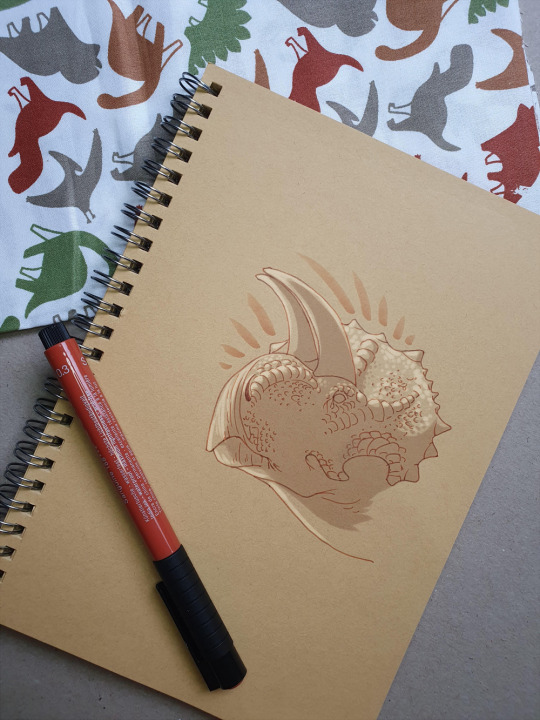
Day 2: Furcatoceratops elucidans
#paleoart#art#dinosaur#prehistoric#paleontology#digitalart#traditionalart#Archovember2023#Dinovember#Dinovember2023#DrawDinovember#DrawDinovember2023#Furcatoceratopselucidans#Furcatoceratops#Nasutoceratopsini#Centrosaurinae#Ceratopsia#archovember#palaeontology
60 notes
·
View notes
Text

Day 2: Kosmoceratops
But with memory vs. reference in lineart.
Do not use my art as base or something like that.
#my art#dinosaur#paleoart#myart#dinosaurs#dinosauria#my drawings#ornithischia#ceratopsia#ceratopsidae#Kosmoceratops#chasmosaurinae#dinocember#sketchbookapp#sketchbook app
43 notes
·
View notes
Text
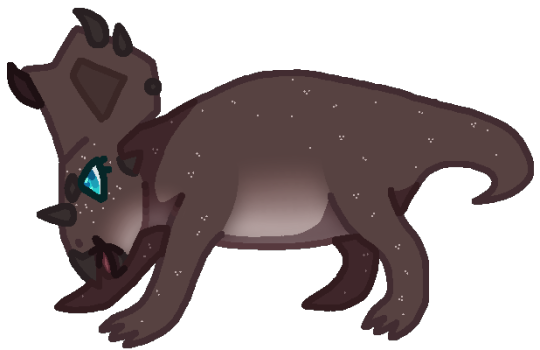
Here's the piece I did for the Primeval Age anniversary event quest, Island Parade!
[Image description: A stylized digital drawing of a young brown styracosaurus with bright blue eyes & pale freckles all over, standing to the side with a devious smile, his head lowered so his nose horn is pointed directly in front of him. End of image description]
In hindsight I would've liked to leave the outline black & only color the lines within the silhouette so he'd look better on a dark background, but oh well. I don't know what kind of background they're going to put him on, and he's dark enough in color that he's probably going to look fine!
#primeval age#feral art#digital art#my art#fawnrats art#paleoart#styracosaurus#ceratopsidae#ceratopsia#dinosaur#non-avian dinosaur#art
7 notes
·
View notes
Note
Speaking of spiffy dinosaurs i think ceratopsians in general are among the spiffy-est
Oh that's definitely true! They really are spiffy
21 notes
·
View notes
Text

Triceratops.
#scars tw#scars cw#dinovember#dinovember2022#art#digital art#illustration#paleo#palaeoblr#paleoart#prehistoric#reptile#archosaur#dino#dinosaur#dinosaurs#ornithiscian#ceratopsia#ceratopsian#triceratops#extinct#extinct animals#an intruder has been spotted
92 notes
·
View notes
Text
Microceratus gobiensis, one of the smallest ceratopsians, and Pentaceratops sternbergii, one of the largest ceratopsians. I made both of these simultaneously, and decided to include them in the same post.
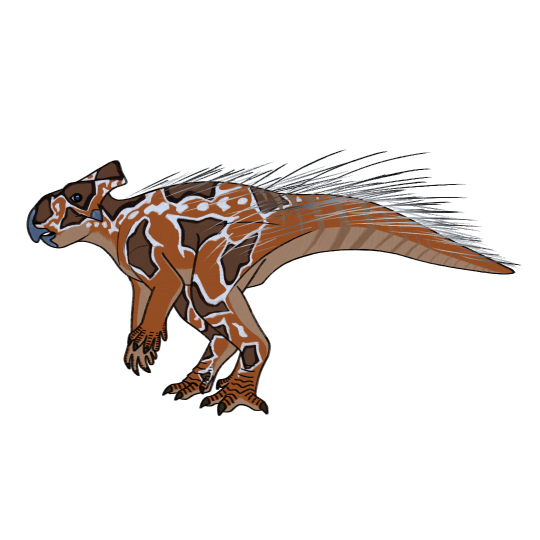

With Hatsune Miku for scale:


#microceratus#pentaceratops#ceratopsian#ceratopsidae#ceratopsia#dinosaur#dinosaurs#digital doodle#digital doodles
19 notes
·
View notes
Text

Concept for a Furcatoceratops dinosauroid, stylized to look like the other dinosauroids I've made, so its got that mutant look to it.
#art#artwork#artists on tumblr#colorful#dinosaur#character art#character concept#original character#dinosauroid#dinosaur oc#horns#scales#anthro#furcatoceratops#ceratopsia#dinosaurs#monster girl#monster gal#dinosaur girl
15 notes
·
View notes
Text
Auroraceratops rugosus

Auroraceratops was a genus of neoceratopsian dinosaur from the Early Cretaceous period. Its type species is Auroraceratops rugosus. The first specimen was found in the Xinminpu Group of Gansu Province, China. As of 2021, fossils from over 80 different individuals have been recovered, ranging from fragments to complete skeletons.
Its autapomorphies include noticeably large nasals; fungiform expansion of the dorsal end of the lacrimal; a significantly rugose jugal, dentary, and surangular; horizontal caudally-directed processes of the pterygoid ventrally covering the base of the skull; and large, striated premaxillary teeth.
Auroraceratops was a small, bipedal herbivore, sporting a large head with a small, bony frill and a beak. It had five toes on its front legs and four on its hind legs. It may possibly be closely related to either Yamaceratops or Graciliceratops.
Original paper: ou, H.; Li, D.; Ji, Q.; Lamanna, H.; Dodson, P. (2005). "On a new genus of basal Neoceratopsian dinosaur from the Early Cretaceous of Gansu Province, China". Acta Geologica Sinica. 79 (5): 593–597.
Wikipedia article: https://en.m.wikipedia.org/wiki/Auroraceratops
#dinosaur#dinosuaria#paleoart#paleontology#artwork#original art#human artist#auroraceratops#neoceratopsidae#ceratopsia#ceratopsian#obscure fossil animals#obscure fossil dinosaurs#obscure fossil tetrapods
14 notes
·
View notes
Link
“Unlike humans, dinosaurs did not have an umbilical cord because they laid eggs. Instead, the yolk sac of dinosaurs was directly attached to the body via a slit-like opening, also found in other egg-laying land animals. It is this opening that sealed up at about the time the animal hatches, leaving a distinctive long umbilical scar. While the egg-laying nature of dinosaurs predicts a long belly button scar, this study is the first to support this hypothesis with fossil evidence.”
#paleontology#psittacosaurus#ceratopsia#marginocephalia#ornithischia#dinosaur#soft tissue preservation#belly button#umbilical scar#this specimen just *keeps on giving*
555 notes
·
View notes
Text
Furcatoceratops elucidans Ishikawa et al., 2023 (new genus and species)
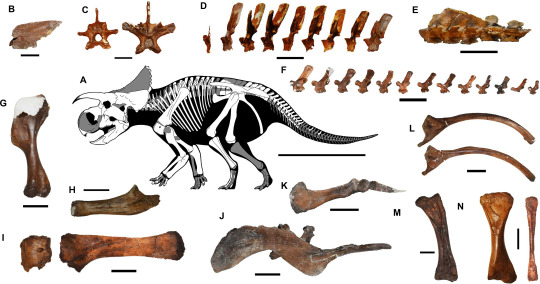
(Schematic skeletal and select bones of Furcatoceratops elucidans [scale bars = 1 m for the skeletal and 10 cm for individual bones], with preserved bones in white, from Ishikawa et al., 2023)
Meaning of name: Furcatoceratops = forked [in Latin] horned face [in Greek]; elucidans = elucidating [in Latin]
Age: Late Cretaceous (Campanian), between 75.2–76.3 million years ago
Where found: Judith River Formation, Montana, U.S.A.
How much is known: Nearly complete skeleton of one individual.
Notes: Furcatoceratops was a centrosaurine ceratopsian, making it a horned dinosaur more closely related to Styracosaurus and Pachyrhinosaurus than to Triceratops. It appears to have been especially closely related to Nasutoceratops, which lived at around the same time in what is now Utah. Whereas Nasutoceratops had distinctive brow horns that curved out to the sides, however, the brow horns of Furcatoceratops pointed almost straight ahead.
The degree of fusion among the skull bones in the type specimen of Furcatoceratops as well as microscopic examination of its bone structure indicate that it was not fully mature when it died, and may have been around 2–3 years old. However, it was already close in size to some adult individuals of closely related ceratopsians.
Historically, research on ceratopsians has focused heavily on their skulls, with less attention paid to the rest of their skeleton. Given its highly complete preservation, the type specimen of Furcatoceratops will likely be valuable for understanding these neglected portions of ceratopsian anatomy.
Reference: Ishikawa, H., T. Tsuihiji, and M. Manabe. 2023. Furcatoceratops elucidans, a new centrosaurine (Ornithischia: Ceratopsidae) from the upper Campanian Judith River Formation, Montana, USA. Cretaceous Research advance online publication. doi: 10.1016/j.cretres.2023.105660
106 notes
·
View notes
Text
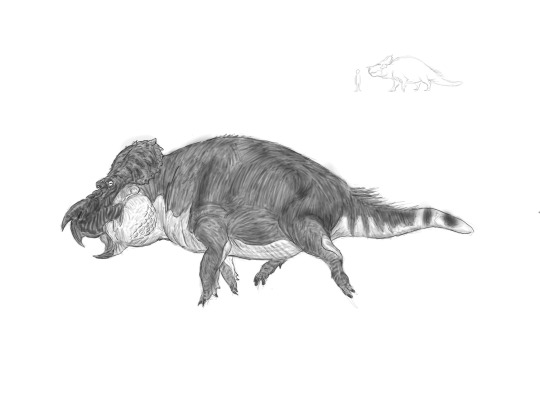
Aurungo-Pundapi (artwork by Yuujinner)
Kingdom: Animalia
Phylum: Chordata
Class/Clade: Reptilia (Sauropsida)
Clade: Diapsida
Clade: Archosauria
Clade: Dinosauria
Order: Ornithischia
Clade: Marginocephalia
Suborder: Ceratopsia
Family: Ceratopsidae
Subfamily: Centrosaurinae
Clade: Eucentrosaura
Tribe: Centrosaurini
Genus: Deinoceratops
Species: D. susoides (”pig-like terrible horned face”)
Ancestral species: Centrosaurus apertus
Time period: Pleistocene to modern day (1.5 million years to present).
Information:
In the eastern swamps of the Isle of Perils, we encounter a most bizarre species: Deinoceratops susoides (“pig-like terrible horned face”), better known by its Xenogaean name, the aurungo-pundapi, “the one whose face is adorned with scars”.
A centrosaurine ceratopsid, the aurungo-pundapi is unusual not only in its semiaquatic habits, not unlike those of a hippopotamus, but also its diet: an omnivore, this creature eats mostly aquatic vegetation like reeds and lilies, but it also eats, among other things, carrion, fish, and the young of other dinosaurs, and it may even go after small crocodylomorphs in its habitat. Of course, as an animal which shared its habitat with other large meat-eaters, including rhizodonts and theropods many times larger than it, the aurungo-pundapi is quite territorial: this animal will usually rush at attackers first and ask questions later, and it is so widely-feared for its ferocious temper, that early European explorers in the region dubbed it the “lizard-hippo” in reference to its similar size, niche, and temperament to its namesake. However, unlike the hippopotamus of Africa, the aurungo-pundapi’s aggression frequently extends to its own species to the point where no two animals will ever congregate within the same stretch of water outside of the mating season. During late June and throughout early July, the males are at their most aggressive: during this time, they enter a state similar to musth in male elephants wherein their hormones spike, causing them to become highly aggressive towards other animals. It was during one such mating season in 1938 that a bull aurungo-pundapi went on a rampage in a village in the marshlands, killing many livestock and people alike before it was finally shot and killed by the villagers. As this animal’s bulk (which is actually comprised mostly of lean muscle instead of fat) makes it difficult for this animal to move efficiently on land, mating usually occurs in the water, which is made possible thanks to the animal’s ability to hold its breath for nearly 2 hours at a time. After the pair have mated, they go separate ways and in a few weeks time, the female will lay her clutch of around 4-8 eggs in a small nest on land which she will visit regularly, removing and adding dirt regularly as needed. In another month, the young will hatch, and for the first few years of their life, they will be dependent on her for protection until they are big enough to fend for themselves, after which she will chase them off. By age 10, they will have reached full size and by age 14, they will have reached sexual maturity, and by this point in their life, few predators will ever dare to harm them. Thus, a healthy aurungo-pundapi can expect to live to a ripe old age of 60-70 years.
This is a revamped version of an old, old creature!
#speculative evolution#novella#fantasy#scifi#scififantasy#speculative biology#speculative fiction#speculative zoology#worldbuilding#dinosaur#ceratopsian#ceratopsia#ornithischians#fantasy creature#sci fi creature#archosaur#spec evo#creature design#creature art#sci-fi creature
4 notes
·
View notes
Text

Day 27: Udanoceratops tschizhovi
#paleoart#art#dinosaur#prehistoric#paleontology#digitalart#traditionalart#Archosaur#Archovember2023#Archovember#Dinovember#Dinovember2023#DrawDinovember#DrawDinovember2023#Udanoceratops#Udanoceratopstschizhovi#Leptoceratopsidae#Ceratopsia#paleoblr#palaeoblr#digital art
40 notes
·
View notes